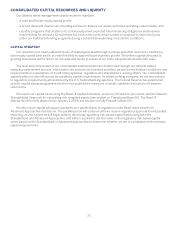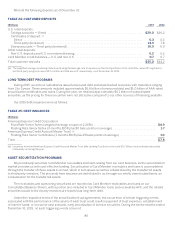American Express 2015 Annual Report Download - page 92
Download and view the complete annual report
Please find page 92 of the 2015 American Express annual report below. You can navigate through the pages in the report by either clicking on the pages listed below, or by using the keyword search tool below to find specific information within the annual report.
LIQUIDITY MANAGEMENT
We incur liquidity risk that arises in the course of offering our products and services. Our liquidity objective is to
maintain access to a diverse set of on- and off-balance sheet liquidity sources. We seek to maintain liquidity sources,
even in the event we are unable to raise new funds under our regular funding programs during a substantial weakening
in economic conditions, in amounts sufficient to meet our expected future financial obligations and our businesses’
requirements for liquidity for a period of at least twelve months. Our liquidity risk policy sets out our objectives and
approach to managing liquidity risk.
The liquidity risks that we are exposed to could arise from a wide variety of scenarios. Our liquidity management
strategy thus includes a number of elements, including, but not limited to:
• Maintaining diversified funding sources (refer to the “Funding Strategy” section for more details);
• Maintaining unencumbered liquid assets and off-balance sheet liquidity sources;
• Projecting cash inflows and outflows under a variety of economic and market scenarios;
• Establishing clear objectives for liquidity risk management, including compliance with regulatory requirements;
• Incorporating liquidity risk management as appropriate into our capital adequacy framework.
We seek to maintain access to a diverse set of on-balance sheet and off-balance sheet liquidity sources, including
cash and other liquid assets, committed bank credit facilities and ABS conduit facilities. Through our U.S. bank
subsidiaries, we also hold collateral eligible for use at the Federal Reserve’s discount window.
The amount and type of liquidity resources we maintain can vary over time, based upon the results of stress
scenarios required under the Dodd-Frank Wall Street Reform and Consumer Protection Act (Dodd-Frank) and other
regulatory measures of liquidity, such as the Liquidity Coverage Ratio (LCR), as well as additional stress scenarios
required under our liquidity risk policy. These stress scenarios possess distinct characteristics, varying by cash flow
assumptions, time horizon and qualifying liquidity sources, among other factors. Scenarios under our liquidity risk
policy include market-wide, firm-specific and combined liquidity stresses. The LCR rule prescribes cash flow
assumptions over a 30-day period and establishes qualifying criteria for high-quality liquid assets. We consider other
factors in determining the amount and type of liquidity we maintain, such as economic and financial market conditions,
seasonality in business operations, growth in our businesses, potential acquisitions or dispositions, the cost and
availability of alternative liquidity sources and credit rating agency guidelines and requirements.
The investment income we receive on liquidity resources, such as cash, is less than the interest expense on the
sources of funding for these balances. The net interest costs on these amounts have been substantial. The level of
future net interest costs depends on the amount of liquidity resources we maintain and the difference between our
cost of funding these amounts and their investment yields.
Securitized Borrowing Capacity
As of December 31, 2015, we maintained our committed, revolving, secured borrowing facility, with a maturity
date of July 15, 2018, that gives us the right to sell up to $3.0 billion face amount of eligible AAA notes from the
American Express Issuance Trust II (the Charge Trust together with the Lending Trust, the Trusts). We also
maintained our committed, revolving, secured borrowing facility, with a maturity date of September 15, 2017, that
gives us the right to sell up to $2.0 billion face amount of eligible AAA certificates from the Lending Trust. Both
facilities are used in the ordinary course of business to fund seasonal working capital needs, as well as to further
enhance our contingent funding resources. As of December 31, 2015, $1.0 billion was drawn on the Charge Trust
facility and $0.1 billion was drawn on the Lending Trust facility, both of which were subsequently repaid on January 15,
2016.
Federal Reserve Discount Window
As insured depository institutions, the Banks may borrow from the Federal Reserve Bank of San Francisco,
subject to the amount of qualifying collateral that they may pledge. The Federal Reserve has indicated that both credit
and charge card receivables are a form of qualifying collateral for secured borrowings made through the discount
window. Whether specific assets will be considered qualifying collateral and the amount that may be borrowed against
the collateral remain at the discretion of the Federal Reserve.
We had approximately $50.9 billion as of December 31, 2015 in U.S. credit card loans and charge card receivables
that could be sold over time through our securitization trusts or pledged in return for secured borrowings, to provide
further liquidity, subject in each case to applicable market conditions and eligibility criteria.
81
























